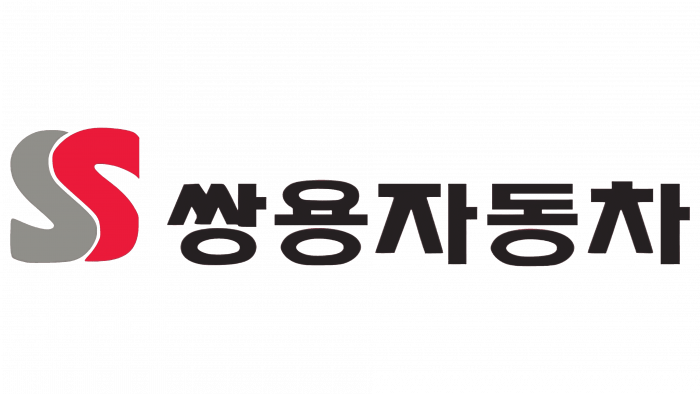The SsangYong logo, which features spread wings, reflects the company’s aspiration to distant horizons and focus on leadership. This stylization is understandable in any country where the automaker supplies products, so the trademark uses a graphic logo, not a text one.
Ssangyong: Brand overview
Meaning and History
Two independent companies founded this brand. One was established in 1954 and was called Ha Dong-hwan Motor Workshop. The second was young and had been in the automotive industry since 1962 under Dongbang Motor Co. In 1963, they were merged into the Ha Dong-hwan Motor Co. A year later, she started manufacturing buses, trucks, military jeeps, and other specialized equipment.
In this status, the company existed until 1977, when it changed its name to Dong-A Motor. Then, in 1984, it came under the control of Keohwa, a South Korean company based in Seoul that engaged in the export production of jeeps. In 1986, the company was taken over by the SsangYong Business Group. It became a part of it and adopted its current name. Frequent transitions from one structure to another affect the identity. Its emblems sometimes differ sharply from each other. She has seven of them in total.
What is SsangYong?
It is a South Korean car manufacturer. It was founded by the merger of Dongbang Motor Co (1962) and Dong-hwan Motor Workshop (1954). The merger took place in 1963. SsangYong is expected to move to Edison Motors in 2021 due to bankruptcy.
1950s – the 1960s
The first logo was very simple. It consisted of a single V on a brown background. The sign’s shape also resembled a checkmark, usually used to indicate points. A thin yellow underline was drawn under the symbol.
the 1960s – 1978
After the redesign, the logo changed in style and color. Now, it was a bold black checkmark with narrow tops. Above it (more precisely, in it) was another letter – “H,” made in a font from the ExtraBold category. The developers made it flat lines and well-defined angles.
1978 – 1987
The authors chose the icon from the previous version for the updated logo but only changed its color. Therefore, it was painted in blue and white colors. But besides the V-shaped checkmark, there were also thin circular lines. All graphic elements were placed in a blue square. On the right, they placed the company name written in Korean. A rectangular frame in light gray surrounded the emblem.
1988 – 1989
In this version, the designers changed the font, using smaller hieroglyphs. They also changed the badge, placing the English company name in a ribbed pattern of oblique stripes. The letters were white, the lines were blue, and the background was gray. In the lower-left corner, there was a miniature yellow triangle.
1989 – 1997
Adhering to the principle of authenticity, the car brand left the Korean spelling of the name for a while. But he changed the icon on the left, so the graphic sign was composed of two elongated “S” – the first letters of the brand name. One character is gray; the other is red.
1992 – the 2000s
In 1992, the company adopted a new identity that did not resemble any earlier versions. The logo depicted three rings: one large and even, the other two flat since they were drawn as if from the side. Therefore, outwardly, they resembled uneven ovals. All lines were painted in two colors: half-white and blue. In addition, an inscription appeared at the bottom—”SSANGYONG MOTOR.”
the 2000s – today
The current emblem has changed the concept. She is as close as possible to the phrase “SsangYong,” which, in South Korean translation, means “twin dragon.” Therefore, the logo features two wings united by a common figured element. Each side has three strokes of different lengths and widths: the inner “feathers” are wide, and the outer ones are narrow. The modern name of the automobile brand is placed under them.
Ssangyong: Interesting Facts
SsangYong Motor Company, a cornerstone in South Korea’s automotive landscape, excels in crafting durable SUVs, pickup trucks, and opulent vehicles. Tracing its decades-long journey reveals a heritage, evolution, and resilience story.
- Foundational Era: Since its inception in 1954, SsangYong has been one of South Korea’s pioneering vehicle manufacturers. Initially focusing on jeeps for the US Army alongside buses and trucks, it laid the groundwork for its diverse automotive expertise.
- Symbolic IdentitysangYong, meaning “Double Dragons” in Korean, reflects the company’s aspiration towards strength and vitality, which is reflected in its automotive creations and corporate vision.
- International Collaborations: SsangYong’s journey is marked by significant global partnerships, notably with Daimler-Benz in the 1990s. This collaboration was instrumental in refining SsangYong’s engineering prowess, particularly in SUV development.
- Economic Challenges and Shifts in Ownership: The company’s path has been fraught with financial hurdles, leading to ownership transitions, including a phase under SAIC Motor Corporation Limited and later Mahindra & Mahindra, showcasing its adaptive strategies in turbulent times.
- Trailblazing Designs: Introduced in the 1990s, the Musso emerged as one of the first SUVs to blend 4×4 functionality with passenger car comfort, paving the way for future innovations in the SUV domain.
- Venture into Electric Mobility: In alignment with global sustainability trends, SsangYong has ventured into electric vehicle production, launching the Korando e-Motion in 2021, marking its foray into the burgeoning EV market.
- Motorsport Engagement: With a history in rally racing, SsangYong has leveraged motorsports to hone the endurance and performance of its vehicles, underlining its commitment to automotive excellence.
- Design Ethos: Merging Korean heritage with contemporary trends, SsangYong strives to craft vehicles that balance elegance and functionality. Its design principle, “Nature-born 3 Motion,” draws inspiration from natural harmony, infusing this essence into its vehicle aesthetics.
- Worldwide Footprint: Despite its trials, SsangYong upholds a global presence, exporting to regions across Europe, Asia, Africa, and Oceania, celebrated for its robust 4x4s and SUVs.
- Technological and Safety Advancements: The company prioritizes cutting-edge technology and safety enhancements, enriching the driver’s experience and bolstering its position in the international automotive arena.
SsangYong Motor Company’s narrative is a testament to its enduring spirit and dedication to innovation. It continuously evolves to craft vehicles that resonate with contemporary needs while cherishing its rich legacy and foundational values.
Font and Colors
This brand has a very turbulent history associated with the frequent transition of the company from one structure to another. This activity was reflected in the evolution of the logo, which is not at all similar to the previous versions in some periods. Moreover, the manufacturer adhered to the Korean spelling of the name for a long time, and only after the onset of the new millennium did they switch to the English version.
The car brand chose a simple typeface for its graphic designation – austere, printed, smooth, sans serif. Moreover, both words are written together, although they are marked with capital letters “S” and “Y.”
The original palette consists of blue and white. Early varieties also include yellow, red, and gray.
FAQ
Is SsangYong Korean or Chinese?
The brand is an automaker from South Korea specializing in SUVs such as Rexton, Korando, and Musso. It is known as the best choice in Korea for this type of car. Over time, the company has put much effort into making diesel engines better and more environmentally friendly. This has helped it stand out in the automobile market in Korea and worldwide by offering high-quality and efficient vehicles.
Are SsangYong reliable?
South Korean automakers, often confused with Chinese ones, are known for their reliable cars. The company has made great strides in engine technology, especially diesel engines, improving their reliability. Owners report that these vehicles are well-built and last a long time. Models like the Rexton and Korando are known for their performance and comfort, offering more than you’d expect for their price. This makes the brand a good choice for those looking for a reliable and affordable car.
What does the SsangYong logo mean?
The logo features two dragons, which match the brand’s name, meaning “double dragon” in Korean. The dragons are stylized as intertwined to form one pair of wings. The use of dragons, symbols of power and mysticism in many East Asian cultures, shows the brand’s uniqueness.
Who is SsangYong made by?
The brand is managed by Mahindra Motor Co., an Indian company known for manufacturing transportation equipment. Mahindra acquired the South Korean automaker and began producing cars under its name. This partnership combines South Korean automotive skills with Mahindra’s resources to create quality vehicles for local and international markets. The company faced financial difficulties, which led it to sell Edison Motors due to bankruptcy proceedings initiated in 2021.
Does Mercedes own SsangYong?
No, these are separate enterprises, but they work closely together. The South Korean brand uses German-made engines and applies Mercedes-Benz technology to its cars. This partnership helps leverage Mercedes-Benz’s cutting-edge design and technology to improve the performance and reliability of SsangYong’s models.
What car brand has a dragon logo?
Alfa Romeo, an Italian automobile brand, is widely known for its snake logo, adding elegance and mystery.
Other car brands use dragon symbols in their logos. SsangYong from South Korea has a logo depicting two intertwined dragons resembling a pair of wings, directly related to its name, which means “double dragon.” Drako Motors, an American manufacturer of sports electric vehicles, uses a modern stylized dragon in its logo.













